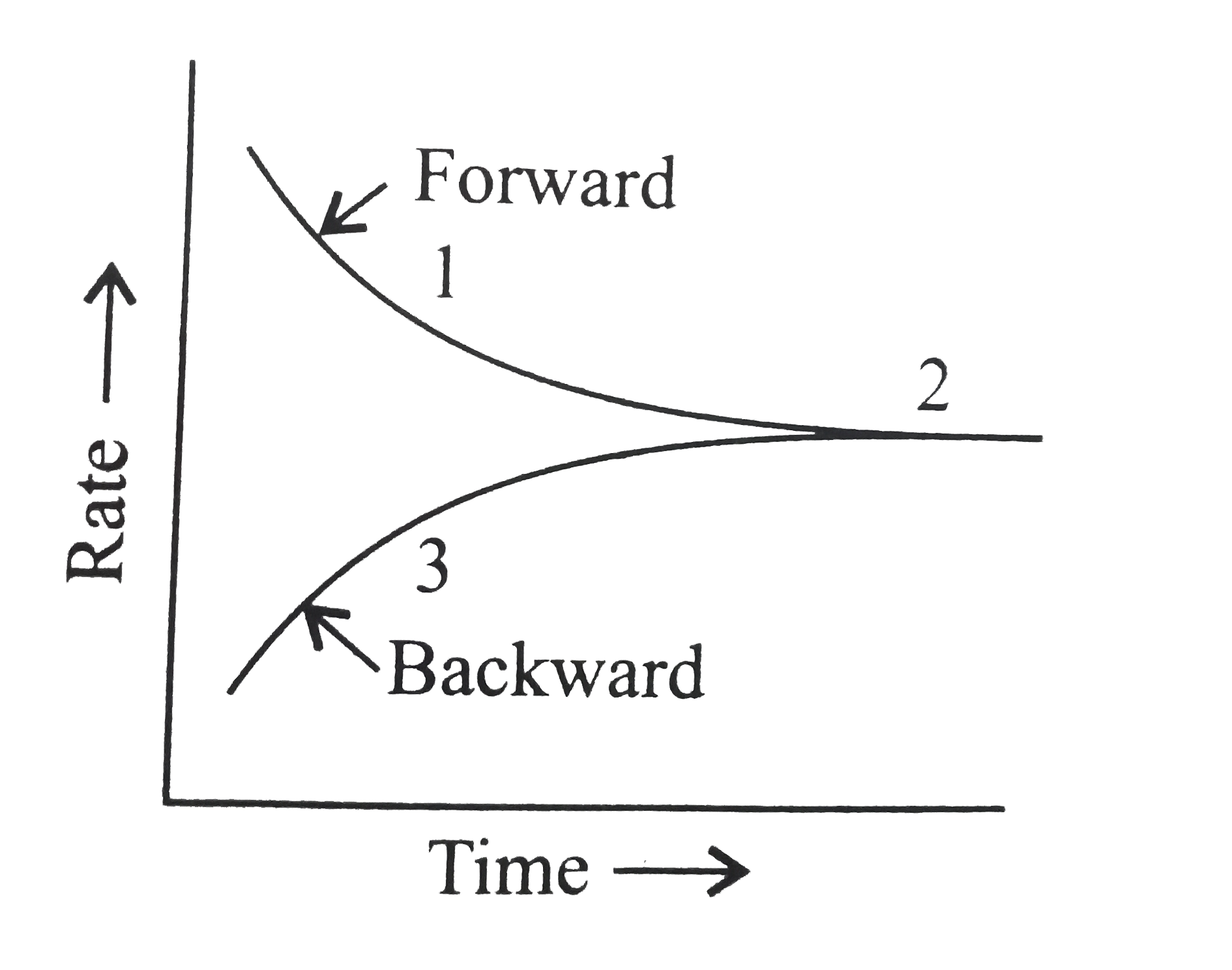Mass action rato or reaction quotient Q for a reaction can be calculate using the law of masss action
A(g)+B(g)⇔C(g)+D(g)
Q=[C][D][A][B]
The value of Q decides whether the reaction is at equilibrium or not.
At equilibrium, Q=K
For an equilibrium process, Q≠K
when Q>K, reaction will favour backward direction and when Q<K, it will favour direction.
Answer the following questions:
The reaction quotient Q for:
O2(g)+2H2(g)⇔2H2O(g)
is given by Q=[H2O]2[O2][H2]2. The reaction will proceed in backward direction, when
Q=Kc
Q<Kc
Q>Kc
Q=0
The correct Answer is:C
To determine when the reaction will proceed in the backward direction for the given reaction:
Reaction:
O2(g)+2H2(g)⇌2H2O(g)
Step 1: Write the expression for the reaction quotient (Q).
The reaction quotient Q is calculated using the concentrations of the products and reactants at any point in time. For the given reaction, the expression for Q is:
Q=(H2O)2(O2)(H2)2
Step 2: Understand the relationship between Q and K.
The equilibrium constant K is a specific value of Q when the reaction is at equilibrium. If Q=K, the system is at equilibrium. If Q≠K, the system will shift to reach equilibrium.
Step 3: Determine the conditions for the backward reaction.
The reaction will favor the backward direction (the formation of reactants from products) when the reaction quotient Q is greater than the equilibrium constant K. This indicates that there are too many products relative to the reactants, and the system will shift left to produce more reactants.
Conclusion:
The reaction will proceed in the backward direction when:
Q>K
O2(g)+2H2(g)⇌2H2O(g)
The reaction quotient Q is calculated using the concentrations of the products and reactants at any point in time. For the given reaction, the expression for Q is:
The equilibrium constant K is a specific value of Q when the reaction is at equilibrium. If Q=K, the system is at equilibrium. If Q≠K, the system will shift to reach equilibrium.
The reaction will favor the backward direction (the formation of reactants from products) when the reaction quotient Q is greater than the equilibrium constant K. This indicates that there are too many products relative to the reactants, and the system will shift left to produce more reactants.
The reaction will proceed in the backward direction when:
Topper's Solved these Questions
- CHEMICAL EQUILIBRIUMBOOK - CENGAGE CHEMISTRY ENGLISHCHAPTER - CHEMICAL EQUILIBRIUMEXERCISE - Exercises (Multiple Correct)
26 Videos
- CHEMICAL EQUILIBRIUMBOOK - CENGAGE CHEMISTRY ENGLISHCHAPTER - CHEMICAL EQUILIBRIUMEXERCISE - Exercises (Single Correct)
58 Videos
- CHEMICAL EQUILIBRIUMBOOK - CENGAGE CHEMISTRY ENGLISHCHAPTER - CHEMICAL EQUILIBRIUMEXERCISE - Exercises (Subjective)
46 Videos
- CHEMICAL BONDING AND MOLECULAR STRUCTUREBOOK - CENGAGE CHEMISTRY ENGLISHCHAPTER - CHEMICAL BONDING AND MOLECULAR STRUCTUREEXERCISE - Archives Subjective
15 Videos
- CLASSIFICATION AND NOMENCLATURE OF ORGANIC COMPOUNDSBOOK - CENGAGE CHEMISTRY ENGLISHCHAPTER - CLASSIFICATION AND NOMENCLATURE OF ORGANIC COMPOUNDSEXERCISE - Analytical and Descriptive Type
3 Videos
Similar Questions
Mass action rato or reaction quotient Q for a reaction can be calculate using the law of masss action
A(g)+B(g)⇔C(g)+D(g)
Q=[C][D][A][B]
The value of Q decides whether the reaction is at equilibrium or not.
At equilibrium, Q=K
For an equilibrium process, Q≠K
when Q>K, reaction will favour backward direction and when Q<K, it will favour direction.
Answer the following questions:
In the following reaction:
2SO2(g)+O2(g)⇔2SO3(g)
the equilibrium is not attained. The rate of forward reaction is greater than that of backward reaction. Thus, which of the following is the correct relation between Kp and Qp?
View SolutionMass action rato or reaction quotient Q for a reaction can be calculate using the law of masss action
A(g)+B(g)⇔C(g)+D(g)
Q=[C][D][A][B]
The value of Q decides whether the reaction is at equilibrium or not.
At equilibrium, Q=K
For an equilibrium process, Q≠K
when Q>K, reaction will favour backward direction and when Q<K, it will favour direction.
Answer the following questions:
For the reaction:
2A+B⇔3C at 298K,Kc=40
A 4L vessel contains 2,1, and 4 mol of A, B and c, respectively. The reaction at the same temperature
View SolutionMass action rato or reaction quotient Q for a reaction can be calculate using the law of masss action
A(g)+B(g)⇔C(g)+D(g)
Q=[C][D][A][B]
The value of Q decides whether the reaction is at equilibrium or not.
At equilibrium, Q=K
For an equilibrium process, Q≠K
when Q>K, reaction will favour backward direction and when Q<K, it will favour direction.
Answer the following questions:
In the reaction:
NH4Cl(g)⇔NH3(g)+HCl(g)
a graph is plotted to show that the variation or the rate of forward and backward reaction against time.
Which of following is correct?

View SolutionThe reaction quotient Q for :
N2(g)+3H2(g)⇔2NH3(g) is given by Q=[NH3]2[N2][H2]3 The reaction will proceed in backward direction, when :
View SolutionMass action rato or reaction quotient Q for a reaction can be calculate using the law of masss action
A(g)+B(g)⇔C(g)+D(g)
Q=[C][D][A][B]
The value of Q decides whether the reaction is at equilibrium or not.
At equilibrium, Q=K
For an equilibrium process, Q≠K
when Q>K, reaction will favour backward direction and when Q<K, it will favour forward direction.
Answer the following questions:
In a reaction mixture containing H2,N2 and NH3 at partial pressure of 2 atm, 1 atm and 3 atm respectively, the value of Kp at 700K is 4.00×10−5atm−2. In which direction the net reaction will go?
N2(g)+3H2(g)⇔2NH3(g)
View SolutionThe Kc for given reaction will be A2(g)+2B(g)⇔C(g)+2D(s)
View SolutionThe reaction Quotient (Q) predicts:
View SolutionThe equilibrium constant Kp for the reaction H2(g)+I2(g)⇔2HI(g) changes if:
View SolutionTwo moles of each reactant A and B are taken in a reaction flask. They react in the following manner,
A(g)+B(g)⇔C(g)+D(g)
At equilibrium, it was found that the concentration of C is triple to that of B the equilibrium constant for the reaction is
View SolutionThe gaseous reaction A(g)+B(g)⇔2C(g)+D(g)+q kJ is most favoured at :
View Solution
